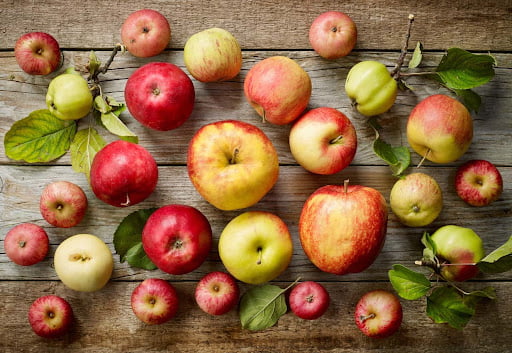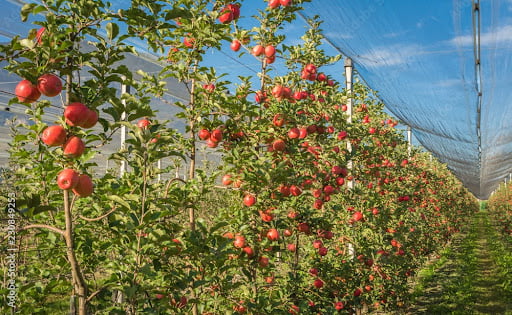Table of Contents
8 Interesting Facts about Apples You didn’t Think You Needed to Know
We all know an apple, right? You know…. looks red or green, tastes good. It reminds you of the famous idiom- “An apple a day keeps the doctor away” as well. But how much do we truly know about apples?
just like escape room are present across the world, Apple trees are cultivated across the world, and they are the most widely grown species in the genus Malus. The apple tree (Malus Domestica) bears apple fruit everywhere, but it did originate in Central Asia. Malus Sieversil, the wild ancestor of the Malus Domestica, is still found in that same region. It was later brought to North America by the European colonizers.
Etymology
The word apple (æppel in Old English) is derived from the Proto-Germanic root *ap(a)lazy, which could also mean fruit in general. This is, in turn, derived from Proto-Indo-European *ab(e)l-. The precise original meaning and the historical relationship between both words is still a topic of research. As late as the 17th century, the word also functioned as a generic term for all fruit other than berries but included nuts.
Origin
Malus sieversii is recognized as a major progenitor species to the cultivated apple as it happens to be morphologically similar. Due to the genetic variability in Central Asia, this region is considered the center of origin for apples. The apple is thought to have been domesticated 4000–10000 years ago in the Tian Shan mountains (from the trees growing in the western region) and then traveled along the Silk Road to Europe, with hybridization with wild crab apples from Siberia (M. baccata), the Caucasus (M. Orientalis), and Europe (M. sylvestris).
For the last 2000 years in China, M. Asiatica and M. prunifolia variants of apples have been cultivated to be used as dessert apples. In Kazakhstan, these apples were considered across the variants M. baccata and M. sieversii. The wild M. sieversii origin apples are slightly smaller than the modern domesticated apple, which is unusual.
Near Udine in North-eastern Italy, seeds from some variants of apples have been found in material carbon dated as far as around 4000 BCE. Genetic analysis has not yet been successfully used to determine their ancestry as it is usually very hard to distinguish in the archaeological records between foraged apples and cultivated apples.
There is also indirect evidence of apple cultivation in the third millennium BCE in the Middle East. There was substantial apple production in the European classical antiquity, and grafting was a well-known term. Grafting is an integral part of apple cultivation, but it is unclear when it started being included in the process.
Winter apples (picked in autumn) have been an important food in Asia, Europe, and Latin America for a very long time. It was certainly popular since the 14th century, at least. But apples were only introduced to North America as a consequence of colonization in the 17th century. The first apple orchard on the North American continent was planted in Boston by Reverend William Blaxton in 1625. The only apples that are native to North America are crab apples, also known as the “common apples .”It was the apple cultivars brought as seeds from Europe that were spread along Native American trade routes, as well as being cultivated on colonial farms.
Apple Cultivation
Many people assume that apple cultivation is a three-month-long process, but that is not true. Apple cultivation is a yearlong process, with only the harvest time being three months. The process goes in this order- breeding, pollination, maturation, harvest, and then finally storage.
The apple crops ripen at different times of the year according to the particular cultivar. Cultivars that yield their crop in the summer include: ‘Gala,’ ‘Golden Supreme,’ ‘McIntosh,’ ‘Transparent,’ ‘Primate,’ ‘Sweet Bough,’ and ‘Duchess .’The fall producers include ‘Fuji’, ‘Jonagold’, ‘Golden Delicious’, ‘Red Delicious’, ‘Chenango’, ‘Gravenstein’, ‘Wealthy’, ‘McIntosh’, ‘Snow’, and ‘Blenheim’. The winter producers include ‘Winesap,’ ‘Granny Smith,’ ‘King,’ ‘Wagener,’ ‘Swayzie,’ ‘Greening,’ and ‘Tolman Sweet.’
The storage method varies based on the cultivar. But usually, they can be stored for a few months in a controlled environment that delays ethylene-induced ripening. To prevent this ripening, apples are commonly stored in chambers with higher concentrations of carbon dioxide and high air filtration. Non-organic apples can also be protected from ripening with the help of 1-methyl cyclopropane.
8 Interesting Facts about Apples You Didn’t Know
Now that we have an idea of what exactly an apple is and how it is produced, doesn’t that make you curious about certain interesting facts about them as well? There is a lot more to apples than their health benefits and good taste. There are a lot of interesting facts about apples, but we have limited our list to 8 really interesting facts about apples you didn’t know.
The Forbidden Fruit:
The original sin is a term we hear often. The biblical apple fruit that Adam and Eve took a bite from. But the apple is a significant fruit in Norse and Greek mythology as well. In Homer’s Iliad, Eris, the goddess of Chaos, used a golden apple to orchestrate the Judgement of Paris episode and, in turn, sowed the seed of the Trojan War. In Norse mythology, Iduna, the goddess of spring, is the keeper of the Immortality Apple. All gods must take a bite of the apple to preserve their youth.
Poisonous Seeds:
Apple seeds are poisonous. It might be a morbid fact, but also, you don’t know when this information might be of some use. Apple seeds contain a Cyanide. This is a deadly poison that is difficult to digest, but one needs to consume at least 200 seeds or 10 apple cores in order to feel the effects.
Fear of Apples
There is an actual term for fear of eating apples. It is called MalusDomesticaphobia. As we have learned from the etymology of the term Apple, we know Malus Domestica is the scientific name of the cultivated Apple.
A decade-long commitment
It takes around 10 years for an apple seed to bear fruit. It also depends on what kind of seed or rootstock it is. Typically, the dwarf trees bear fruit before others. If you plant a seed today, you might as well wait a decade to taste the fruits of your labor (pun intended).
7500 cultivars
There are roughly 7500 cultivars or varieties of apples. This is a tremendous number of varieties for a single fruit. The cultivars are spread across the world, and all taste and look unique. Their cultivation and storage techniques vary. So does their farming season. Apples are actually one of the most diverse fruit in terms of their variety. The most common varieties of apples in the world are the Red Delicious, Granny Smith, Gala, Golden delicious, Lady, Baldwin, McIntosh, Honey crisp, Fuji, and Cortland.
The discovery of the American (apple) Pie
Your grandma’s favorite apple pie recipe that you inherited as a family heirloom? Yeah, that was an accidental discovery. Apple Pies are not an original American delicacy. But rather native to Europe. The dessert delicacy became popular in Europe in the 1300s.
At first, you were not supposed to eat the crust as well. The crust was made of a mixture of flour, lard, and water to act as a dish for the apple pie. Since it turned out to be tasty, the crust was then included as part of the food as well.
Johnny Appleseed
John Chapman, an American nurseryman, also regarded as Johnny Appleseed, is not fictional. That caught you off-guard, right? He is a character famous in American Folklore as we know it. But he was a real person who introduced apple trees to large parts of Pennsylvania, Ohio, Indiana, Illinois, and Ontario, as well as West Virginia.
He did it for the sake of financial gain, but in turn, it also helped the environment and popularized the fruit in North America. He planted apple trees to later sell them off as his own land. It was typical of that time to claim the land as your own if you had planted an orchard there. Apple Cider, in fact, was an invention that came out as a consequence of Appleseed’s low-quality apples.
Apples can Float
You are probably aware of the fact that apples can float. But do you know why that happens? Apples can float in water because they are less dense than water. They are buoyant because 25% of their volume is just air. This is actually very common between fall season fruits. The apple skin, seed, and apple juice doesn’t come close to the amount of air in apple fruits. Even if they are tested individually, it is only the apple seed that sinks and not the other parts. Even if the apple is rotten, it will continue to float and not sink.
Apples are filled high in fiber, Vitamin C as well as antioxidants. They are a versatile fruit that can be used for various purposes and not just for consumption. Now that you are aware of such interesting facts about apples eat at least one apple a day to keep the doctor at bay.

